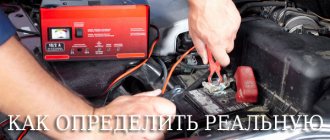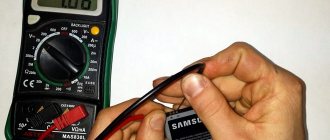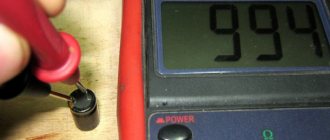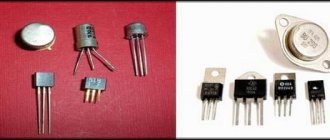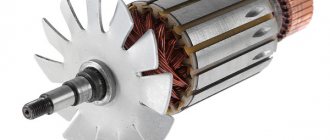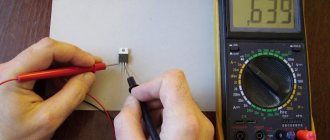There are different batteries, so the approach to measuring parameters is individual. 18650 is the designation of the most popular Li-Ion battery, the dimensions of which are slightly larger than a standard AA battery (18x65 mm). Everything that applies to the 18650 battery also applies to other lithium-ion batteries!
The typical size of these batteries is often used in small flashlights, lasers, and various electronics. Batteries for laptops, some screwdrivers, and even electric cars are assembled from 18650 components. It's amazing how useful and powerful this battery is. Not every specialist knows how to correctly determine the capacity of a 18650 battery. That is why there are so many articles on the Internet on the topic of checking capacitance characteristics.
Checking 18650 battery capacity
Capacity is considered one of the most basic characteristics for any rechargeable battery. And the 18650 battery is no exception. Many manufacturers highlight the nominal capacity on the battery casing, but this characteristic is generally overestimated.
In order to check the capacity of an 18650 battery, both special measuring devices and simple homemade devices are used. So, more about checking the performance of the battery:
- You can determine the approximate real capacity by simply charging the battery with a known current. Most often, the charge current is indicated in the charger specifications. If it takes 34 hours to fully recharge a battery with a current of 100 mA, then by multiplying these two values, we can come to the conclusion that the capacity of such a battery corresponds to 3400 mAh. Do not forget that the data obtained is inaccurate, because everything depends on the algorithm of the memory.
- There is an even faster and more accurate method for changing the capacity of an 18650 battery, which requires money. To perform the manipulation, you will need to purchase an intelligent charger. Such chargers will not only display the actual voltage and capacity of the battery, but will also greatly simplify battery maintenance.
- The third way to determine capacity is the most interesting. The lower the discharge current, the more accurate the indicators. You will need a fully charged battery, a watch, an ammeter and, for example, a flashlight. Surely the 18650 battery was purchased for its use. You don't need an ammeter if you have a specification with data on how much current the flashlight consumes in a certain brightness mode. Turn on the lighting device and adjust the minimum brightness, measure the current with an ammeter and note the time. For example, the gadget illuminated for 20 hours, absorbing a current of 100 mA. 20 x 100 = 2000 mAh. Alas, the battery capacity leaves much to be desired; 2000 mAh is not much.
It is also necessary to highlight that only well-known organizations such as Panasonic, Samsung, Elgie indicate the exact battery capacity. And then these characteristics, when measured, may differ from those officially declared by the manufacturer by + - 50 mAh. And maybe more if the battery turns out to be used or defective. Unfortunately, such batteries are sometimes sold on the market, but at low prices.
Now let’s look at the second method of determining capacitive characteristics. Checking 18650 via iMax B6. First of all, you need to find the iMax B6 smart charger. Its main advantage is its versatility and measurement of the capacitive characteristics of the battery.
Measuring the capacity of 18650 batteries is not a quick process. First, charge to 100%, then discharge to 0, measuring the ampere hours given, then you need to put the battery into storage mode. Read about how to charge a 18650 battery and with what current.
The next step will be the assembly of a BMS balancing charger based on the same iMax B6, which allows you to charge up to six batteries at once, controlling the charge of each at the same time. Success, but partial. You will have to check the capacity of the batteries one by one, because when checking several batteries at once, you can only get average values. However, this data will be enough to understand whether everything is okay with the battery.
Important! Measurements of the values of various parameters using a multifunction meter are performed starting from the highest range. This is required to avoid burning the insides of the device and causing electrical injury. In general, you should never forget about safety precautions, since current can be very harmful to anyone.
Types of batteries
Portable batteries differ both in operating principle and in appearance. Main types of batteries:
- Finger (size designation AA);
- Pinky (size AAA);
- Large cylindrical (size D);
- Medium cylindrical (designated C);
- Krone type (shape - parallelepiped);
- Flat (shape - flattened parallelepiped).
All cylindrical types of charge storage devices have an operating voltage of 1.2 to 1.6 volts. The voltage of Kron type elements is 9 V, and flat 4.5 V. The performance of the element depends on the load to which it is connected.
In low-power devices, a decrease in battery voltage does not affect performance for a long time, but in powerful devices, such as cameras or electric motors, even a slight drop in voltage will cause equipment failure.
Batteries also differ in the type of internal filling. The following types are distinguished:
- “Salt”, “dry” - carbon-zinc. This type of battery is the cheapest, but it discharges the fastest and does not work well in cold conditions and with powerful loads;
- HeavyDuty - zinc chloride, similar to the previous type, have a slightly larger capacity;
- “Alkaline”, alkaline - work better at low temperatures and hold a charge at high current, but discharge quickly;
- With the use of mercury - high-capacity, they are difficult to quickly discharge, however, due to the danger of mercury, they have fallen out of use;
- Using silver - they discharge slowly and work well with a powerful load, but are expensive;
- Lithium - have the highest capacity and the smallest weight among similar ones. Long shelf life. High price.
Also, all batteries are divided into two types: primary, that is, galvanic cells and secondary, that is, rechargeable or rechargeable. The former are usually cheaper, but must be disposed of after use. The latter often have a lower capacity, are more expensive, but can be recharged with a charger.
What you need for verification
To check, you can take a regular and inexpensive multimeter. The device combines an ammeter, voltmeter and ohmmeter and is universal. Also, technicians sometimes find out the capacity using iMax and testers, because these devices are easy to use.
What parameters can be checked using a multimeter
Using this device you can measure the capacity of a 18650 battery, volume, voltage between its poles, internal resistance, leakage current. Of course, many people believe that a multimeter can be replaced with a tester, but this is not always the case; each case is individual.
Video
For those who are interested in how to measure battery capacity, keep the charge under control and restore capacity, we present a video.
https://youtube.com/watch?v=6vKYo2nirTo
I’m sharing my idea of the easiest way to measure battery capacity without buying expensive measuring instruments. The test sample was a 18650 lithium-ion battery, but my method of measuring capacity will work for other batteries as well. The first part of the article describes a budget option for measuring capacitance using a cheap USB tester. In the second, measuring the capacity of a lithium-ion battery without using measuring instruments (without a multimeter and a USB tester). At the end of the article there is a short review and several photographs of a USB tester sent from China.
Li-Ion batteries.
Modern electronic devices widely use lithium-ion (Li-Ion) batteries of various shapes and sizes. Regardless of the standard size, they all have similar characteristics and, by and large, differ only in capacity. As a rule, there are batteries with a nominal voltage of 3.7 Volts (although there are also 3.8 Volts). 3.7 V Li-Ion batteries cannot be charged above a voltage of 4.23 V and cannot be discharged below 2.5 V, otherwise an irreversible process will occur and the cell will only have to be thrown away. The battery can be discharged and charged to any value (it does not have a memory effect), as long as the voltage is in the range from 2.5 to 4.23 V. However, a completely discharged battery should be charged as soon as possible so that it does not lose its capacity prematurely. Also, lithium-ion batteries differ from each other in the presence of protection. The battery may have no electronic protection (just a galvanic cell), or it may have a built-in circuit that protects the cell from over-discharge, overcharging and overheating. But no matter how you protect and monitor the condition of the battery, its capacity will steadily decrease over time. The higher the operating temperature and the more charge-discharge cycles are performed, the faster the battery ages.
18650 Li-ion battery.
18650 is the designation of the most common Li-Ion battery, the dimensions of which are slightly larger than a regular AA battery (18x65 mm). Everything that applies to the 18650 battery also applies to other lithium-ion batteries! The 18650 battery size is often used in high-power flashlights, lasers, and various electronics. Batteries for laptops, some screwdrivers, and even electric vehicles are assembled from 18650 cells. If you buy a branded battery, it most likely has built-in electronic protection. Cheap Chinese batteries, ordered for example from Aliexpress, do not have protection. In addition, their capacity is usually several times lower than declared.
How to measure voltage
Many people use rechargeable batteries, but completely forget about such a parameter as voltage, which ultimately leads to dire consequences, or rather to breakdown. Voltage measurement using a multimeter is performed in the following way:
- The measuring device is switched to voltage mode up to 20 V;
- The tips of the probes are attached to the power terminals;
- After a couple of seconds, the battery voltage can be seen on the screen, if this does not happen, try repeating the first two steps again.
Reference! If the “-” sign appears on the display next to the digital symbols, this means that a “polarity reversal” occurred when connecting the clamping parts or probes. This is not dangerous, but for the normal functioning of the meter, it is better to avoid such errors. Take your time when measuring voltage, this is already a short procedure.
Signs of breakdown
Electronics are a complex thing, so it is quite difficult to determine a battery failure based only on external signs. But, if you initially know the main signs of a power failure, then this task becomes much easier. Therefore, it is worth remembering the main signs indicating an insufficient charge or breakdown of the car battery. Among them:
- no light from the battery charge indicator;
- clicks when starting the starter;
- slow starter operation;
- weak headlights.
All car electronics malfunction if the battery has a weak charge. Although the problems may be due to other reasons, a set of these signs clearly means a battery problem.
Advice! If your battery has a built-in charge indicator, then determining its performance is much easier. Often the indicator has two colors: green and white. The first indicates the normal condition of the device, and the second means the fluid level is low. If the indicator does not work at all, then the battery needs to be charged.
If one of these symptoms occurs, it is recommended to check the car battery using available methods. It is also recommended to conduct an external inspection, including searching for damage, as well as checking the reservoirs and electrolyte.
How to measure capacitance
Measuring a battery with a multimeter is much easier than others. However, not everyone can do this the first time, perhaps due to fear of failure. To give courage, various schemes and recommendations have been created that are freely distributed on the World Wide Web. How to check the capacity of a 18650 battery with a multimeter:
- the battery needs to be completely filled with energy, then a load must be connected to it;
- Afterwards it is necessary to note the time;
- At the same moment, you need to connect the clamping parts of the multimeter to the poles, switching it to the measuring range of up to 20 Watts. This manipulation is needed in order to monitor the level of decline in the potential difference.
- The actual type of capacity value is found by performing a standard calculation: multiplying the current consumed by the load by the time it operates from a fully charged battery. The obtained data is expressed in Ampere-hours (A*hour, Ah).
Now there are many universal 18650 chargers with the option of determining the capacity; they help, with a small error (depending on the manufacturer), to determine the exact capacity of such batteries. Model chargers are one of the first convenient microprocessor chargers that allow you to test almost all types of batteries for capacity; the only thing that also needs to be observed is the requirement to minimize connections in the component connection chain to reduce losses and increase accuracy.
In addition to model devices, it is necessary to connect balancing cables to the power cables so that the characteristics can be measured through them and the 4-point testing method can be used. And also the brand plays an important role in all this. AI Charger is one of the most popular manufacturers due to the fact that the accuracy of its devices and their stability are quite high.
Important! Perform all manipulations with lithium-ion batteries wearing safety glasses. Do not short-circuit the “+” and “-” cells directly (without loads). Do not overcharge or overdischarge lithium components above or below the values specified in their official documentation. All information provided in this article is for informational purposes only and does not constitute instructions for use.
Control measurement
We put the discharged 18650 battery on charge and wait. If during the charging process the voltage cannot cross the 4 Volt mark, then we send it straight to the trash, and it won’t even be possible to restore it. Otherwise, this still doesn’t mean anything and we continue to freeze...
By capacity
As we move beyond the 4V mark, we look at the capacity. If it is less than 200 mAh, then it can also be safely disposed of. For any working battery, the capacity should already go beyond 800 mAh to 4 volts.
If you really don’t want to rush, then you can do a full discharge and put it on charge again. If the capacity becomes larger the second time when crossing the four-volt boundary, then you can repeat it many times and try to “swing” the jar.
Upon voltage sag
So, our test subject is charged to 4.2V, what next? You can measure the internal resistance with the same devices that I mentioned above. If the internal resistance is significantly higher than that of similar workers, then it’s also in the landfill.
There is nothing to measure internal resistance with? So we apply Ohm's Law for the complete circuit. We connect a small load. If the voltage immediately drops below the standard operating 3.6 V, it also means “HANA”.
With iMax
We wrote about the iMax and all the tricks it allows you to do with batteries in this review of the iMax B6. He can measure the capacity in the most correct way - directly by complete discharge and charge. And it can be restored by charging with a low current, plus “swinging”.
Considering the dense presence of different batteries everywhere in our lives, I think it’s worth buying it once.
Only a tester and a homemade circuit
Well, see about it in the video below:
The best coupons and discounts right now on Aliexpress. Here on this page there are discounts up to 90%!
How to check leakage current
Rarely do any users encounter a leak, but such cases still occur. Leakage current is a dangerous, undesirable phenomenon for any rechargeable power supply. To check the 18650 battery you will need a rheostat and a multimeter. Charge the battery, connect the rheostat and set the appropriate resistance to obtain the required current. Using a multimeter, take readings over time, discharge the battery and also take readings. Enter all data into a table, which will later need to be analyzed for the presence of drawdown.
Note! You can also take a resistor to check; with this device you can do the job twice as fast. but you will need to be a little more careful. If no problem is detected in the battery, the meter display will show three zeros.
So you have learned how to test a battery with a multimeter.
How to measure the battery charge with a multimeter and not damage anything inside? In order for the test to be truly successful, or rather without damaging the internals, it is necessary to set the correct measuring range. So, for example, when checking the potential difference of a 12-volt battery, the device is transferred to the range of up to 20 V.
Are there differences in testing batteries for different devices?
In order to find out the capacity of a 1865O battery, it is not necessary to run for a multimeter or an expensive tester; you can calculate the value using special tools and software. Everyone chooses the appropriate option for themselves. However, there are more video tutorials on the topic of testing batteries with a multimeter. If you check the battery for a laptop or car, you will have to perform almost the same steps. However, different measuring devices must be used.
The capacity of an 18650 battery can be measured using a load or a tester. To calculate the battery capacity, you will have to act as with a car battery. If you know how to measure the capacity of an 18650 battery and decipher the color markings, then you can monitor this important characteristic and install a new battery in time when the capacity drops to the minimum set value. Without knowing how to correctly measure the capacity, you can use the battery for a long time at a low value, which will negatively affect the equipment itself, which is dependent on the battery.
There are differences in testing the performance of batteries for different devices, but not significant. The most important thing is to learn how to measure the battery capacity correctly, then there will be no special problems in the future. After all, one way or another, it is better to perform preventive maintenance than to buy a new element to replace.
Multimeter indicators
A multimeter is a popular tool not only for motorists.
It is used in any area where it is necessary to measure current: voltage, resistance and its strength. Its versatility is characterized by the fact that the device includes the following:
- Voltmeter.
- Ammeter.
- Ohmmeter.
The device is compact and can be easily carried and stored in a car. Thanks to constant use to check the condition of the battery, it can be maintained in working condition for a long time.
Read also: How to quickly drain a screwdriver battery
There are several versions of such a device.
When choosing it, it is recommended to pay attention to the following:
- Constant voltage measurements are carried out ranging from 0 to 200 mV, as well as 2 V, 20 V, 200 V, 1000 V.
- DC current can be measured within 2 mA, 20 mA, 200 mA.
- The alternating voltage ranges from 0 to 200 V, 750 V.
- Resistance can be measured from 0 to 200 ohms.
There are more complex versions of the multimeter.
Some useful tips
Useful tips will help you improve the quality of battery use and understand how to dispose of them:
- Don't delay checking and sorting batteries that accumulate in your home over time. If there are no new ones, or there are too few of them, you can use the tested ones for a while.
- If the batteries in a household unit are dead, it is not necessary to change the entire set. The fact is that they do not sit down at the same time, but with the help of inspection it will be possible to detect elements suitable for further use.
- Do not keep worn-out batteries at home; remove them from the equipment casing in a timely manner. Over time, electrolyte will begin to leak out of them, leading to damage to your favorite appliances.
- There is no need to try to damage the outer shell of the battery housing - the liquid inside (acid or alkali) can cause chemical burns if it comes into contact with the skin.
In addition, damaged batteries should not be thrown away with regular trash, because they contain electrolyte, a substance that is harmful to the environment. Hand them over at special points where they are sent for recycling.
These are all the secrets of how to check the battery capacity with a multimeter, and in which devices the tested elements can be used. To take measurements, you only need a tester and a few free minutes.
https://youtube.com/watch?v=HIP6Dp2xwJI
Simple capacity study
Battery capacity
The procedure is intuitively clear from the name of the unit. The capacity of the energy carrier is measured in amperes per hour. For small batteries, a more precise division is used - their volume is measured in milliamps per hour. Converting amperes to milliamps and vice versa is very simple:
- In the first case, the value is multiplied by one thousand.
- In the second, they divide by the same value.
The logic of the operation is clear from the physical meaning of the unit. The indicated number implies the amount of amperes of outgoing current that the device can provide in an hour of operation, while using up the entire charge. People who do not know physics can guess the necessary actions based on the mathematical meaning. The number of amps per hour refers to the amperage multiplied by the operating time.
Equipment used
In any case, you will need wires, because without them it will not be possible to assemble an electrical circuit. You definitely need a device that will be powered by battery energy, for example, a light bulb. But since research requires a full discharge, you should select a lamp with the highest energy consumption. If you couldn’t find one, you can connect any household appliance. A small freezer works well.
You can’t do without measuring instruments:
- watch;
- ammeter or voltmeter.
It is preferable to find an ammeter, because when using a voltmeter you will need to know the exact resistance values. It is better if the car enthusiast has both devices. When examining a helium battery, you must include a special relay in the circuit that will protect the device from complete discharge.
Steps to follow
The first step is to charge the battery. Since it is necessary to find the entire volume, the device must be fully charged. Then the chain is assembled. It includes measuring instruments, relays, if necessary, and an energy consumer. The clock must also be powered from a common circuit, having previously set the time to zero.
When the electricity runs out, they will turn off, preserving the system's operating time. After this, the key is closed, and the circuit is temporarily forgotten. You just need to set the ammeter readings in advance, that is, the strength of the outgoing current. When the battery runs out, it's time for some simple arithmetic. You need to take a calculator and multiply the current by the operating time of the system - this is the desired value.
It can be found by adding the external resistance of the network with the internal resistance related to the current source. You also need to know what the emf of the battery is. After this, it is enough to find the current strength by dividing the emf by the total resistance. The resulting value must also be multiplied by the time of full discharge.

